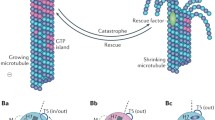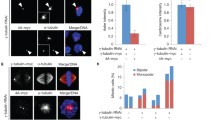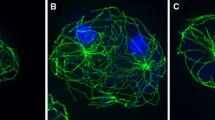Abstract
Microtubules interact with huge protein complexes not only with their minus ends but also with their peripheral plus ends. The centrosome at their minus ends nucleates and organizes the microtubule cytoskeleton. The microtubule plus end complex seems to be required for the capture of microtubule tips at cortical sites by mediating interactions of microtubule tips with cortical actin as well as with membrane proteins. This process plays a major role in nuclear migration, spindle orientation and directional cell movement. Five potential members of the microtubule plus end complex have already been identified in Dictyostelium, DdCP224, DdEB1, DdLIS1, the dynein heavy chain and dynein intermediate chain. DdCP224 and DdEB1 are the Dictyostelium representatives of the XMAP215- and EB1-family, respectively. Both are not only concentrated at microtubule tips, they are also centrosomal components. The centrosomal binding domain of DdCP224 resides within the C-terminal fifth of the protein. DdCP224 is involved in the centrosome duplication cycle and cytokinesis. DdEB1 is the first member of the EB1 protein family that is also a genuine centrosomal component. A DdEB1 null mutant revealed that DdEB1 is required for mitotic spindle formation. DdEB1 coprecipitates and colocalizes with DdCP224 suggesting that these proteins act together in their functions. One of these functions could be dynein/dynactin-dependent interaction of microtubule tips with the cell cortex that is thought to determine the positioning of the microtubule-organizing center (MTOC) and the direction of migration.
Similar content being viewed by others
References
Akhmanova A, Hoogenraad CC, Drabek K, Stepanova T, Dortland B, Verkerk T, Vermeulen W, Burgering BM, De Zeeuw CI, Grosveld F and Galjart N (2001) Clasps are CLIP-115 and-170 associating proteins involved in the regional regulation of microtubule dynamics in motile fibroblasts. Cell 104: 923–935.
Allan V and Näthke IS (2001) Catch and pull a microtubule: getting a grasp on the cortex. Nat Cell Biol 3: E226-E228.
Barth AI, Siemers KA and Nelson WJ (2002) Dissecting interactions between EB1, microtubules and APC in cortical clusters at the plasma membrane. J Cell Sci 115: 1583–1590.
Beach D and Bloom KS (2001) The dynein intermediate chain, Pac11p, localizes to the microtubule plus ends. Mol Biol Cell 12S: 165a.
Beaudouin J, Gerlich D, Daigle N, Eils R and Ellenberg J (2002) Nuclear envelope breakdown proceeds by microtubule-induced tearing of the lamina. Cell 108: 83–96.
Beinhauer JD, Hagan IM, Hegemann JH and Fleig U (1997) Mal3, the fission yeast homologue of the human APC-interacting protein EB-1 is required for microtubule integrity and the maintenance of cell form. J Cell Biol 139: 717–728.
Berrueta L, Tirnauer JS, Schuyler SC, Pellman D and Bierer BE (1999) The APC-associated protein EB1 associates with components of the dynactin complex and cytoplasmic dynein intermediate chain. Curr Biol 9: 425–428.
Bloom K (2000) It's a kar9ochore to capture microtubules. Nat Cell Biol 2: E96-E98.
Cassimeris L, Gard D, Tran PT and Erickson HP (2001) XMAP215 is a long thin molecule that does not increase microtubule stiffness. J Cell Sci 114: 3025–3033.
Charrasse S, Schroeder M, Gauthier Rouvieve C, Ango F, Cassimeris L, Gard DL and Larroque C (1998) The TOGp protein is a new human microtubule-associated protein homologous to the Xenopus XMAP215. J Cell Sci 111: 1371–1383.
Chen XP, Yin H and Huffaker TC (1998) The yeast spindle pole body component Spc72p interacts with Stu2p and is required for proper microtubule assembly. J Cell Biol 141: 1169–1179.
Coquelle FM, Caspi M, Cordelieres FP, Dompierre JP, Dujardin DL, Koifman C, Martin P, Hoogenraad CC, Akhmanova A, Galjart N, De Mey JR and Reiner O (2002) LIS1, CLIP-170's key to the dynein/dynactin pathway. Mol Cell Biol 22: 3089–3102.
Daunderer C, SchliwaMand Gräf R (1999) Dictyostelium discoideum: a promising centrosome model system. Biol Cell 91: 313–320.
De Lozanne A and Spudich JA (1987) Disruption of the Dictyostelium myosin heavy chain gene by homologous recombination. Science 236: 1086–1091.
Desai A and Mitchison TJ (1997) Microtubule polymerization dynamics. Annu Rev Cell Dev Biol 13: 83–117.
Drewes G, Ebneth A, Preuss U, Mandelkow EM and Mandelkow E (1997) MARK, a novel family of protein kinases that phosphorylate microtubule-associated proteins and trigger microtubule disruption. Cell 89: 297–308.
Dujardin DL and Vallee RB (2002) Dynein at the cortex. Curr Opin Cell Biol 14: 44–49.
Etienne-Manneville S and Hall A (2001) Integrin-mediated activation of Cdc42 controls cell polarity in migrating astrocytes through PKCzeta. Cell 106: 489–498.
Euteneuer U, Gräf R, Kube-Granderath E and Schliwa M (1998) Dictyostelium gamma-tubulin: molecular characterization and ultrastructural localization. J Cell Sci 111: 405–412.
Faulkner NE, Dujardin DL, Tai CY, Vaughan KT, O'Connell CB, Wang Y and Vallee RB (2000) A role for the lissencephaly gene LIS1 in mitosis and cytoplasmic dynein function. Nat Cell Biol 2: 784–791.
Fodde R, Kuipers J, Rosenberg C, Smits R, Kielman M, Gaspar C, van Es JH, Breukel C, Wiegant J, Giles RH et al. (2001) Mutations in the APC tumour suppressor gene cause chromosomal instability. Nat Cell Biol 3: 433–438.
Garces JA, Clark IB, Meyer DI and Vallee RB (1999) Interaction of the p62 subunit of dynactin with Arp1 and the cortical actin cytoskeleton. Curr Biol 9: 1497–1500.
Garcia MA, Vardy L, Koonrugsa N and Toda T (2001) Fission yeast ch-TOG/XMAP215 homologue Alp14 connects mitotic spindles with the kinetochore and is a component of the Mad2-dependent spindle checkpoint. Embo J 20: 3389–3401.
Gard DL and Kirschner MW (1987) A microtubule-associated protein from Xenopus eggs that specifically promotes assembly at the plusend. J Cell Biol 105: 2203–2215.
Goode BL, Drubin DG and Barnes G (2000) Functional cooperation between the microtubule and actin cytoskeletons. Curr Opin Cell Biol 12: 63–71.
Gräf R (2001) Isolation of centrosomes from Dictyostelium. Methods Cell Biol 67: 337–357.
Gräf R, Brusis N, Daunderer C, Euteneuer U, Hestermann A, Schliwa M and Ueda M (2000a) Comparative structural, molecular and functional aspects of the Dictyostelium discoideum centrosome. Curr Top Dev Biol 49: 161–185.
Gräf R, Daunderer C and Schliwa M (1999) Cell cycle-dependent localization of monoclonal antibodies raised against isolated Dictyostelium centrosomes. Biol Cell 91: 471–477.
Gräf R, Daunderer C and Schliwa M (2000b) Dictyostelium DdCP224 is a microtubule-associated protein and a permanent centrosomal resident involved in centrosome duplication. J Cell Sci 113: 1747–1758.
Gräf R, Euteneuer U, Ueda M and Schliwa M (1998) Isolation of nucleation-competent centrosomes from Dictyostelium discoideum. Eur J Cell Biol 76: 167–175.
Gundersen GG (2002) Evolutionary conservation of microtubulecapture mechanisms. Nat Rev Mol Cell Biol 3: 296–304.
Habermann A, Schroer TA, Griffths G and Burkhardt JK (2001) Immunolocalization of cytoplasmic dynein and dynactin subunits in cultured macrophages: enrichment on early endocytic organelles. J Cell Sci 114: 229–240.
He X, Rines DR, Espelin CW and Sorger PK (2001) Molecular analysis of kinetochore-microtubule attachment in budding yeast. Cell 106: 195–206.
Hoogenraad CC, Akhmanova A, Grosveld F, De Zeeuw CI and Galjart N (2000) Functional analysis of CLIP-115 and its binding to microtubules. J Cell Sci 113: 2285–2297.
Karki S and Holzbaur EL(1999) Cytoplasmic dyneinand dynactin in cell division and intracellular transport. Curr Opin Cell Biol 11: 45–53.
Kemler R (1993) From cadherins to catenins: cytoplasmic protein interactions and regulation of cell adhesion. Trends Genet 9: 317–321.
Kimble M, Kuzmiak C, McGovern KN and de Hostos EL (2000) Microtubule organization and the effects of GFP-tubulin expression in Dictyostelium discoideum. Cell Motil Cytoskeleton 47: 48–62.
Kinoshita K, Arnal I, Desai A, Drechsel DN and Hyman AA (2001) Reconstitution of physiological microtubule dynamics using puried components. Science 294: 1340–1343.
Koonce MP and Khodjakov A (2002; this issue) Dynamic microtubules in Dictyostelium. J Muscle Res Cell Motil 23: 641–647.
Koonce MP and Samso M (1996) Overexpression of cytoplasmic dynein's globular head causes a collapse of the interphase microtubule network in Dictyostelium. Mol Biol Cell 7: 935–948.
Koonce MP, Kohler J, Neujahr R, Schwartz JM, Tikhonenko I and Gerisch G (1999) Dynein motor regulation stabilizes interphase microtubule arrays and determines centrosome position. EMBO J 18: 6786–6792.
Korinek WS, Copeland MJ, Chaudhuri A and Chant J (2000) Molecular linkage underlying microtubule orientation toward cortical sites in yeast. Science 287: 2257–2259.
Lee L, Tirnauer JS, Li J, Schuyler SC, Liu JY and Pellman D (2000) Positioning of the mitotic spindle by a cortical-microtubule capture mechanism. Science 287: 2260–2262.
Lee MJ, Gergely F, Jeffers K, Peak-Chew SY and Raff JW (2001) Msps/XMAP215 interacts with the centrosomal protein D-TACC to regulate microtubule behavior. Nat Cell Biol 3: 643–649.
Ligon LA, Karki S, Tokito M and Holzbaur EL (2001) Dynein binds to beta-catenin and may tether microtubules at adherens junctions. Nat Cell Biol 3: 913–917.
Lu B, Roegiers F, Jan LY and Jan YN (2001) Adherens junctions inhibit asymmetric division in the Drosophila epithelium. Nature y409: 522–525.
Ma S and Chisholm RL (2002) Cytoplasmic dynein-associated structures move bidirectionally in vivo. J Cell Sci 115: 1453–1460.
Ma S, Trivinos Lagos L, Gräf R and Chisholm RL (1999) Dynein intermediate chain mediated dynein-dynactin interaction is required for interphase microtubule organization and centrosome replication and separation in Dictyostelium. J Cell Biol 147: 1261–1274.
Manstein DJ, Titus MA, De Lozanne A and Spudich JA (1989) Gene replacement in Dictyostelium: generation of myosin null mutants. EMBO J 8: 923–932.
Matthews LR, Carter P, Thierry Mieg D and Kemphues K (1998) ZYG-9, a Caenorhabditis elegans protein required for microtubule organization and function, is a component of meiotic and mitotic spindle poles. J Cell Biol 141: 1159–1168.
McCartney BM and Peifer M (2000) Teaching tumour suppressors new tricks. Nat Cell Biol 2: E58-E60.
Miller RK, Cheng SC and Rose MD (2000) Bim1p/Yeb1p mediates the Kar9p-dependent cortical attachment of cytoplasmic microtubules. Mol Biol Cell 11: 2949–2959.
Mimori-Kiyosue Y, Shiina N and Tsukita S (2000a) Adenomatous polyposis coli (APC) protein moves along microtubules and concentrates at their growing ends in epithelial cells. J Cell Biol 148: 505–518.
Mimori-Kiyosue Y, Shiina N and Tsukita S (2000b) The dynamic behavior of the APC-binding protein EB1 on the distal ends of microtubules. Curr Biol 10: 865–868.
Muhua L, Adames NR, Murphy MD, Shields CR and Cooper JA (1998) A cytokinesis checkpoint requiring the yeast homologue of an APC-binding protein. Nature 393: 487–491.
Nabeshima K, Kurooka H, Takeuchi M, Kinoshita K, Nakaseko Y and Yanagida M (1995) p93dis1, which is required for sister chromatid separation, is a novel microtubule and spindle pole body-associating protein phosphorylated at the Cdc2 target sites. Genes Dev 9: 1572–1585.
Nakaseko Y, Goshima G, Morishita J and Yanagida M (2001) M phase-specific kinetochore proteins in fission yeast. Microtubuleassociating Dis1 and Mtc1 display rapid separation and segregation during anaphase. Curr Biol 11: 537–549.
Neujahr R, Albrecht R, Kohler J, Matzner M, Schwartz JM, Westphal M and Gerisch G (1998) Microtubule-mediated centrosome motility and the positioning of cleavage furrows in multinucleate myosin II-null cells. J Cell Sci 111: 1227–1240.
Neuwald AF and Hirano T (2000) HEAT repeats associated with condensins, cohesins, and other complexes involved in chromosome-related functions. Genome Res 10: 1445–1452.
Ohba T, Nakamura M, Nishitani H and Nishimoto T (1999) Selforganization of microtubule asters induced in Xenopus egg extracts by GTP-bound Ran. Science 284: 1356–1358.
Ohkura H, Garcia MA and Toda T (2001) Dis1/TOG universal microtubule adaptors-one MAP for all? J Cell Sci 114: 3805–3812.
Palazzo AF, Joseph HL, Chen YJ, Dujardin DL, Alberts AS, Pfister KK, Vallee RB and Gundersen GG (2001) Cdc42, dynein, and dynactin regulate MTOC reorientation independent of Rhoregulated microtubule stabilization. Curr Biol 11: 1536–1541.
Perez F, Diamantopoulos GS, Stalder R and Kreis TE (1999) CLIP-170 highlights growing microtubule ends in vivo. Cell 96: 517–527.
Popov AV, Pozniakovsky A, Arnal I, Antony C, Ashford AJ, Kinoshita K, Tournebize R, Hyman AA and Karsenti E (2001) XMAP215 regulates microtubule dynamics through two distinct domains. EMBO J 20: 397–410.
Popov AV, Severin F and Karsenti E (2002) XMAP215 is required for the microtubule-nucleating activity of centrosomes. Curr Biol 12: 1326–1330.
Rehberg M and Gräf R (2002) Dictyostelium EB1 Is a genuine centrosomal component required for proper spindle formation. Mol Biol Cell 13: 2301–2310.
Rogers SL, Rogers GC, Sharp DL and Vale RD (2002) Drosophila EB1 is important for proper assembly, dynamics, and positioning of the mitotic spindle. J Cell Biol 158: 873–884.
Salina D, Bodoor K, Eckley DM, Schroer TA, Rattner JB and Burke B (2002) Cytoplasmic dynein as a facilitator of nuclear envelope breakdown. Cell 108: 97–107.
Schliwa M and Höner B (1993) Microtubules, centrosomes and intermediate filaments in directed cell movement. Trends Cell Biol 3: 377–380.
Schliwa M, Euteneuer U, Graf R and Ueda M (1999) Centrosomes, microtubules and cell migration. Biochem Soc Symp 65: 223–231.
Schuyler SC and Pellman D (2001) Microtubule 'plus-end-tracking proteins': the end is just the beginning. Cell 105: 421–424.
Schwartz K, Richards K and Botstein D (1997) BIM1 encodes a microtubule-binding protein in yeast. Mol Biol Cell 8: 2677–2691.
Spittle C, Charrasse S, Larroque C and Cassimeris L (2000) The interaction of TOGp with microtubules and tubulin. J Biol Chem 275: 20,748–20,753.
Su LK, Burrell M, Hill DE, Gyuris J, Brent R, Wiltshire R, Trent J, Vogelstein B and Kinzler KW (1995) APC binds to the novel protein EB1. Cancer Res 55: 2972–2977.
Tirnauer JS and Bierer BE (2000) EB1 proteins regulate microtubule dynamics, cell polarity, and chromosome stability. J Cell Biol 149: 761–766.
Tirnauer JS, O'Toole E, Berrueta L, Bierer BE and Pellman D (1999) Yeast Bim1p promotes the G1-speci.c dynamics of microtubules. J Cell Biol 145: 993–1007.
Tournebize R, Popov A, Kinoshita K, Ashford AJ, Rybina S, Pozniakovsky A, Mayer TU, Walczak CE, Karsenti E and Hyman AA (2000) Control of microtubule dynamics by the antagonistic activities of XMAP215 and XKCM1 in Xenopus egg extracts. Nat Cell Biol 2: 13–19.
Ueda M, Gräf R, MacWilliams HK, Schliwa M and Euteneuer U (1997) Centrosome positioning and directionality of cell movements. Proc Natl Acad Sci USA 94: 9674–9678.
Valetti C, Wetzel DM, Schrader M, Hasbani MJ, Gill SR, Kreis TE and Schroer TA (1999) Role of dynactin in endocytic traffic: effects of dynamitin overexpression and colocalization with CLIP-170. Mol Biol Cell 10: 4107–4120.
Vasquez RJ, Gard DL and Cassimeris L (1994) XMAP from Xenopus eggs promotes rapid plus end assembly of microtubules and rapid microtubule polymer turnover. J Cell Biol 127: 985–993.
Vaughan KT, Tynan SH, Faulkner NE, Echeverri CJ and Vallee RB (1999) Colocalization of cytoplasmic dynein with dynactin and CLIP-170 at microtubule distal ends. J Cell Sci 112: 1437–1447.
Vaughan PS, Miura P, Henderson M, Byrne B and Vaughan KT (2002) A role for regulated binding of p150Glued to microtubule plus ends in organelle transport. J Cell Biol 158: 305–319.
Wang PJ and Huffaker TC (1997) Stu2p: a microtubule-binding protein that is an essential component of the yeast spindle pole body. J Cell Biol 139: 1271–1280.
Wasteneys GO (2002) Microtubule organization in the green kingdom: chaos or self-order? J Cell Sci 115: 1345–1354.
Wilde A and Zheng Y (1999) Stimulation of microtubule aster formation and spindle assembly by the small GTPase Ran. Science 284: 1359–1362.
Author information
Authors and Affiliations
Rights and permissions
About this article
Cite this article
Hestermann, A., Rehberg, M. & Gräf, R. Centrosomal microtubule plus end tracking proteins and their role in Dictyostelium cell dynamics. J Muscle Res Cell Motil 23, 621–630 (2002). https://doi.org/10.1023/A:1024450922609
Issue Date:
DOI: https://doi.org/10.1023/A:1024450922609




